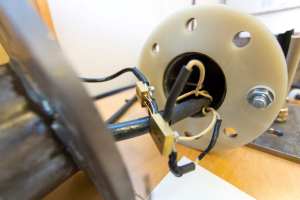
When the condition of galvanic anodes is known, it is easier to plan the necessary service and replacement, and over time this means lower costs. It is therefore sensible to install a monitoring anode to monitor the other galvanic anodes on the installation.
The required knowledge about the condition of the galvanic anodes can be obtained in two ways: by manually performing measurements of the condition at regular intervals, or by installing a permanent system comprising a monitoring anode complete with electronic equipment.
The efficiency of the aluminium anodes can be measured manually on-site using portable reference cells. This requires the incorporation of maintenance plans over the lifetime of the structure, which entails that inspectors must have periodical access to the structures.
A manual measurement often becomes a time-consuming and resource-consuming operation that can only be performed under good weather conditions.
More attention to the galvanic anodes can be obtained if a permanent monitoring system is implemented. Once the monitoring anode has been installed, it requires no further maintenance and usually functions smoothly throughout the designed usual life.
Over a number of years, BAC Corrosion Control has developed methods for monitoring the condition of the galvanic anodes. Today, development has culminated in an established test method that can document the efficiency of the monitoring anodes. It is very advantageous when the precise specifications of the monitoring anode are known already when it is installed, as they form the basis of a very precise calculation of both costs and resources in connection with the ongoing maintenance of the galvanic anodes used.
The system also includes a number of reference cells located strategically on the structure. The information provided by the monitoring system is collected in an automatic logger and measuring unit based on robust, well-known and thoroughly tested data loggers. Finally, the system makes it possible to install alarms in the event of operational irregularities.
BAC’s fixed monitoring anodes may be connected to a monitoring panel or a SCADA system via a PC with a data logger. The collected data can of course also be assessed and monitored in real time on the connected PC.
The system has been optimised for use in connection with galvanic anodes for especially platform anodes and anodes for offshore structures, as well as for offshore wind turbines foundations.
Contrary to the more difficult manual monitoring of the galvanic anodes, an operator using BAC’s fixed monitoring anodes can easily obtain an indication of the anode consumption and the expected useful life without interfering in the anode operating principle. With data for a number of anodes, it is also possible to determine the general trend in relation to the performance of the entire galvanic anode system.
The system can be set to provide automatic alarms, and the sophisticated A/D converter uses its own 12V battery with a capacity of thousands of measurements without any available external power supply.

